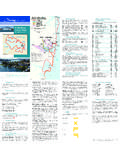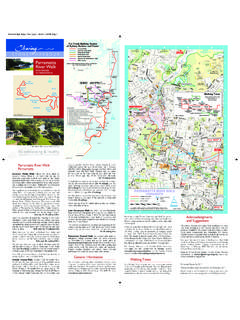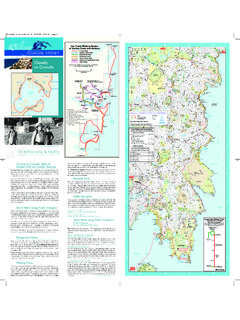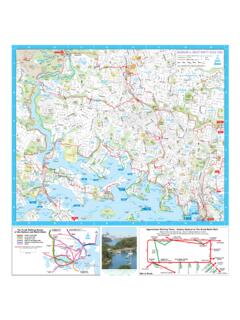Transcription of CIRCULAR QUAY TO SOUTH HEAD AND CLOVELLY
1 CIRCULAR quay TO SOUTH HEAD AND CLOVELLY MAIN WALK SECTION 1: CIRCULAR quay TO RUSHCUTTERS BAY Main Walk: Loop and Connecting Walks: Alternative Routes: Distance: 6km. Time: 2 hours 20 mins. Level: Easy moderate; some steps. Transport: CIRCULAR quay , Kings Cross and Edgecliff Stations; CIRCULAR quay Ferry; CIRCULAR quay , New SOUTH Head Rd buses. Connects with: Federation Track; Loops L1 (Macquarie St), L2 (Kings Cross), L4 (Darling Point); Connection Walks C1 (Woolloomooloo). Facilities: Toilets: CIRCULAR quay , Botanic Gardens, Beare Park, Reg Bartley Oval, Rushcutters Bay Park; Picnic spots: Botanic Gardens, McElhone Reserve, Beare and Rushcutters Bay Parks; Shops or hotels: CIRCULAR quay , Domain, Woolloomooloo, Potts Point, Elizabeth Bay, Rushcutters Bay Park.
2 Graham Spindler 2007 CIRCULAR quay to Rushcutters Bay: 1 The Main Walk begins at CIRCULAR quay , the birthplace of European Sydney. To stand near the CIRCULAR quay ferry wharves is to stand on what, on January 26, 1788, was water. At some point about 200 metres inland on that day, a group of naval officers and marines led by the first Governor of NSW, Captain Arthur Phillip, might have been raising a flag and a tankard of rum near the banks of a small, clear stream of water that was their reason for selecting this spot for a settlement. About the same distance offshore an anchored line of transport ships, each about the size of one of the Manly Ferries which now slip in and out of the wharves, would have been sending ashore longboats of male convicts and equipment, along with the wafting sounds and smells of months of confinement.
3 And all around, on the foreshores and rocky ridges, would have stood the silent, encircling bush, amidst which equally silent, dark figures would have watched the curious new arrivals with quiet, uncertain eyes. It s all a little hard to picture now. The stream still flows, but in pipes beneath roads and buildings planted on what had been tidal mudflats. CIRCULAR quay defines the new shoreline and remains a gateway to Sydney city. It was partly built by the last of the convicts to be sent to Sydney from Britain, and was originally (and more logically) known as Semi CIRCULAR quay .
4 The double deck Cahill Expressway and City Loop railway and station act as both visual barrier and passageway to the city beyond almost all of what can be seen having been built since the opening of the expressway in 1958 one of the few exceptions being Sydney City Library which occupies the fourth of the Customs Houses (1885) that once controlled the imports of the colony. Loop Walk L1 begins at the eastern end of CIRCULAR quay at the glass fronted lift to the Cahill Roadway. The Main Walk stays at the water level and turns left (north). From the eastern end of the ferry wharves turn north, following the arcades and walkways to Sydney Opera House.
5 After almost circling the Opera House, enter the Royal Botanic Gardens via the Opera House Gate. Note the plaques in the paving along this the walkway which commemorate Australian and visiting writers. In the second half of the nineteenth century, the eastern side of CIRCULAR quay was lined by stone warehouses and provided berths for increasingly large overseas passenger steamships. Stone stairs (only Moore Steps from 1865 still survive) linked the lower roadway to Macquarie Street and the Tarpeian Way precinct of the Botanic Gardens. Most of the warehouses persisted until after WWII, replaced in the 1950s and 60s with uninspired glass and concrete office blocks.
6 When these were torn down in the 1990s and the view to the Botanic Gardens and Government House opened up again, there was a sustained public outcry about plans to hide it again behind a new series of buildings which dubbed The Toaster seemed hardly more inspired to the public in architectural terms than their predecessors. However, even though the views did mostly go and the architecture above the fine colonnade at street level is mundane, the result of the Opera Quays development has been a massive reinvigoration of the area and a lively connection to the Opera House.
7 Sydney Opera House stands on Bennelong Point, originally a virtual island and first called Cattle Point by Captain Arthur Phillip and used as a cattle pen for Phillip s farm. It gained its new name from an Aboriginal called Bennelong who played a remarkable role in early Sydney and who lived for a time here in a small hut. Woollarawarre Bennelong, and another man, Colby, had been kidnapped at Governor Phillip s orders in late 1789, in an attempt to learn more about the Aborigines and promote communication with them. Bennelong learnt English quickly, adopted European dress, became a trusted friend of Phillip and contributed greatly to early knowledge of the Eora people and the reasonably peaceful relations of the early years of settlement.
8 He travelled to England when Phillip returned there in 1795 and was something of a hit in English society, even meeting King George III (who was still relatively sane at that point!). His return to Sydney in 1795 was less successful, alcohol and recurring trouble with both whites and blacks contributing to his eventual death at Ryde in 1813. In 1817, Governor Macquarie had convict architect Francis Greenway design a castellated fortress on the point, completed by 1819, which together with Fort Dawes on the western point of Sydney Cove (now the southern pylon of the Harbour Bridge), provided close in defence for the town s most important entry point.
9 The fortress was demolished in 1903 for a castellated tramshed designed by Government Architect W. L. Vernon. A couple of little cafe buildings en route to the Opera House are all that now remain of the tram depot and port facilities. The trams were taken off Sydney s roads by the end of the 1950s and the tramshed demolished in 1960 to make gave way for the Opera House, designed by Danish architect, Joern Utzon, and opened in 1973 after a stormy decade of design changes, political interventions and cost overruns. The building stage was almost as much a source of fascination and controversy for Sydneysiders as the Harbour Bridge had been but it had its sublime moments such as when its first concert was performed from scaffolding for construction workers by American bass and activist, Paul Robeson himself the son of a former slave.
10 The segmented shell skyline became an unquestioned Graham Spindler 2007 CIRCULAR quay to Rushcutters Bay: 2 icon of Sydney, stunning in its setting, and a popular multi purpose cultural centre which had an immediate and huge impact on Sydney life. The Public Works Department designed interior, which was at the centre of the split between the Government and the architect, has little relationship with the wonderful exterior and proves disappointing for some. Thirty years into its life, the split between government and architect was healed and work began on some remodeling.





